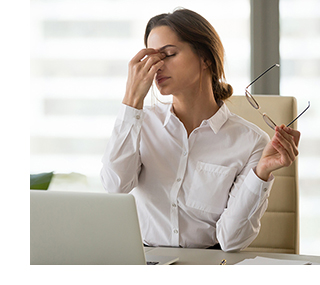
|
|||||||
Patients appreciate that we are a “one-stop shop” for all types of eye care related services including the following: |
 |
 |
 |
 |
 |
 |
 |
 |
 |
We offer many types of treatments for patients who suffer from dry eye |
What are the symptoms of dry eye? Dry eye can cause a scratchy sensation or the feeling that something is in the eye. Other symptoms include stinging or burning,episodes of excess tearing, itching, discharge, pain, and redness in the eye. People with dry eye may also feel as if their eyelids are tired or heavy, and may experience blurred vision, particularly with visual tasks like reading and driving. Tearing due to a dry eye condition happens when the oily layer of the tears is not present, due to plugged eyelid oil glands, and the basal tears evaporate too fast. This triggers the release of “reflex tears” that are like the tears you get when you chop onions. Reflex tears can also blur vision. What are tears and how do they relate to dry eye? In a healthy eye, lubricating tears called basal tears continuously bathe the cornea, the clear, dome-shaped outer surface of the eye. With every blink of the eye, basal tears flow across the cornea, nourishing its cells and providing a layer of liquid protection from the environment. When the glands nearby each eye fail to produce enough basal tears, or when the composition of the tears changes, the health of the eye and vision are compromised. Vision may be affected because tears on the surface of the eye play an important role in focusing light. Tears are a complex mixture of fatty oils, water, mucus, and more than 1500 different proteins that keep the surface of the eye smooth and protected from the environment, irritants, and germs. |
|
| Treatment options |
|
|
Over-the-counter (OTC) topical medications Mild dry eye symptoms may be treated with over-the-counter medications such as artificial tears, gels, and ointments. There are numerous types of tears made by different manufacturers. Our doctors will recommend specific types. Environmental and lifestyle changes
Lid hygiene for Meibomian gland dysfunction
Prescription dry eye medications There are a number of types of topical eye drops that may be helpful. These include mild immunosuppressant eye medications (Restasis or Xiidra) or mild steroid eye drops for short term treatment. Your doctor will advise you if you need one of these medicines. Tear Duct Occlusion Punctal plugs made of silicone or collagen may be inserted by an eye care professional to partially or completely plug the tear ducts at the inner corners of the eye to keep tears from draining from the eye. In severe cases, surgical closure of the drainage ducts by thermal punctal cautery may be recommended to close the tear ducts permanently. Multiple treatments are often needed. |
|

 What is dry eye and what causes it?
What is dry eye and what causes it?